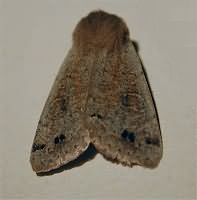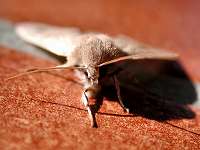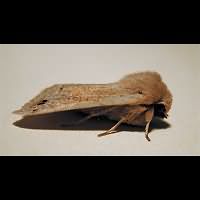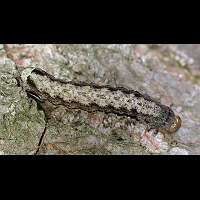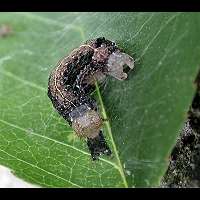Twin-spotted Quaker Perigrapha munda
Within the awkward group of dull Quakers and Drabs the Twin-spotted Quaker is easily identified by the double spot, which gave it its vernacular name. The basic colour of the front wings is variable: often yellowish brown, but it may be reddish brown or greyish brown as well. In very few specimens the double dot is absent. These animals are very similar to the Clouded Drab, but they have the tip of the wings rounded where the tip of the wing of the Clouded Drab is square. The males of the Twin-spotted Quaker have feathered antennae, the females have threadlike antennae. The wingspan corresponds with the wingspan of most Quakers and Drabs and varies between 38 and 44mm.
The eggs are being laid in groups in April on the host plant. They hatch within ten days. The caterpillars feed at night. When small they hide in the foliage during the day. Bigger larvae hide in crevices in the bark of the foodplant. In July the caterpillars are full grown. They drop to the ground, dig a chamber in the ground, spin a cocoon and pupate inside. It is the pupa overwintering. The caterpillars are clearly divided into three sections. There is a broad, light greyish brown dorsal band. In the middle of this band a fine light line. The sides between the dorsal band and the spiracula are dark brown, sometimes almost blackish brown. Below the spiracula the caterpillar of the Twin-spotted Quaker is whitish, sometimes greenish grey. The 11th segment has a black marking on top and sometimes the whole segment seems to be a dark ring. Willow, sallow, elm, oak and almost all trees and shrubs can be hostplants. The caterpillars grow to be some 40mm at most.
The Twin-spotted Quaker is on the wing in March and April mainly. However some specimens may be seen flying about in May. Flies at night, but is sometimes seen in daylight or dusk on willow flowers. The Twin-spotted Quaker also loves bleeding trees. Is easily attracted to light and sugar. Generally distributed, but local in England and Wales. Scarce in Ireland. A local species in Southern and Central Scotland. On the continent a species of light sandy soils, widespread and not uncommon, but never appearing in great numbers.
Untill recently the scientific name used to be Orthosia munda. This species is also known as the Plum Leaf Moth in Australia.
Within the awkward group of dull Quakers and Drabs the Twin-spotted Quaker is easily identified by the double spot, which gave it its vernacular name. The basic colour of the front wings is variable: often yellowish brown, but it may be reddish brown or greyish brown as well. In very few specimens the double dot is absent. These animals are very similar to the Clouded Drab, but they have the tip of the wings rounded where the tip of the wing of the Clouded Drab is square. The males of the Twin-spotted Quaker have feathered antennae, the females have threadlike antennae. The wingspan corresponds with the wingspan of most Quakers and Drabs and varies between 38 and 44mm.
The eggs are being laid in groups in April on the host plant. They hatch within ten days. The caterpillars feed at night. When small they hide in the foliage during the day. Bigger larvae hide in crevices in the bark of the foodplant. In July the caterpillars are full grown. They drop to the ground, dig a chamber in the ground, spin a cocoon and pupate inside. It is the pupa overwintering. The caterpillars are clearly divided into three sections. There is a broad, light greyish brown dorsal band. In the middle of this band a fine light line. The sides between the dorsal band and the spiracula are dark brown, sometimes almost blackish brown. Below the spiracula the caterpillar of the Twin-spotted Quaker is whitish, sometimes greenish grey. The 11th segment has a black marking on top and sometimes the whole segment seems to be a dark ring. Willow, sallow, elm, oak and almost all trees and shrubs can be hostplants. The caterpillars grow to be some 40mm at most.
The Twin-spotted Quaker is on the wing in March and April mainly. However some specimens may be seen flying about in May. Flies at night, but is sometimes seen in daylight or dusk on willow flowers. The Twin-spotted Quaker also loves bleeding trees. Is easily attracted to light and sugar. Generally distributed, but local in England and Wales. Scarce in Ireland. A local species in Southern and Central Scotland. On the continent a species of light sandy soils, widespread and not uncommon, but never appearing in great numbers.
Untill recently the scientific name used to be Orthosia munda. This species is also known as the Plum Leaf Moth in Australia.

